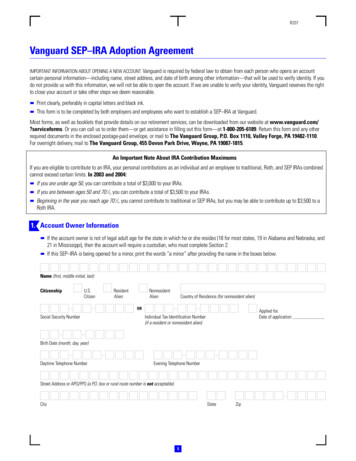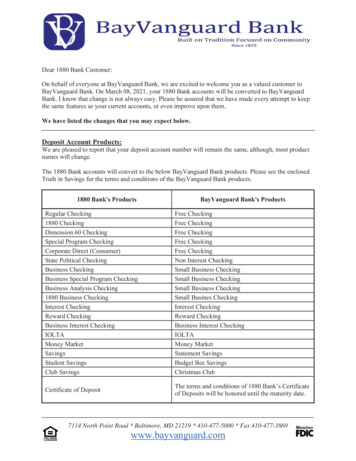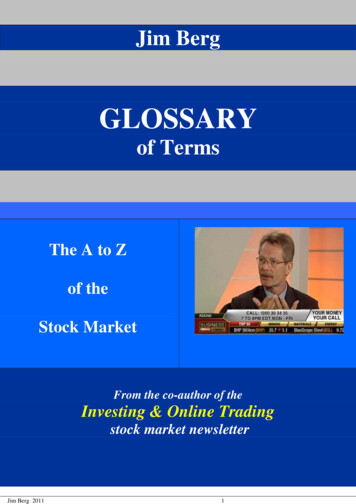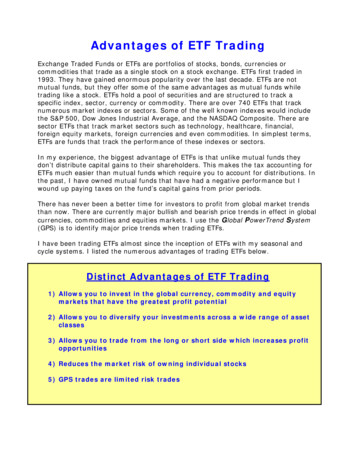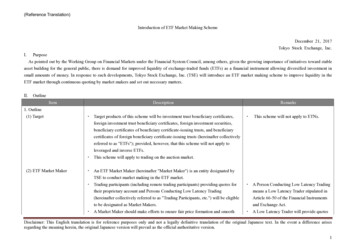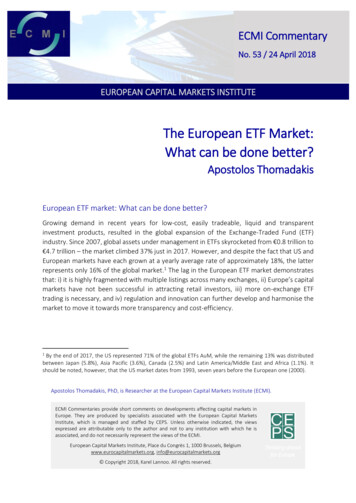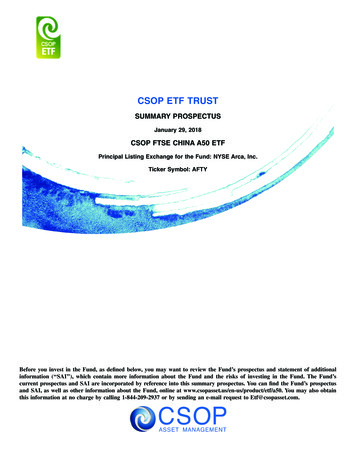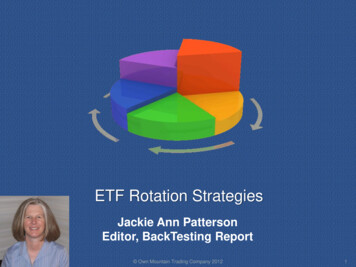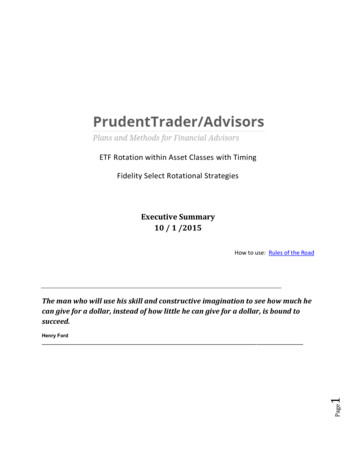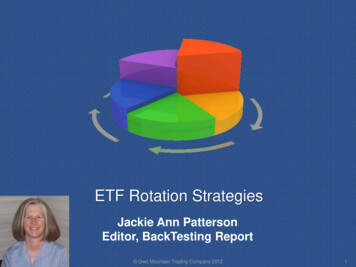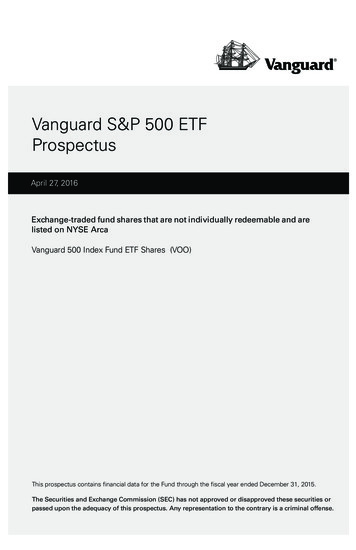
Transcription
Vanguard S&P 500 ETFProspectusApril 27, 2016Exchange-traded fund shares that are not individually redeemable and arelisted on NYSE ArcaVanguard 500 Index Fund ETF Shares (VOO)This prospectus contains financial data for the Fund through the fiscal year ended December 31, 2015.The Securities and Exchange Commission (SEC) has not approved or disapproved these securities orpassed upon the adequacy of this prospectus. Any representation to the contrary is a criminal offense.
ContentsVanguard ETF Summary1Investing in Vanguard ETF Shares7More on the Fund and ETF SharesThe Fund and Vanguard1710Investing in Index Funds9Investment Advisor18Dividends, Capital Gains, and Taxes19Share Price and Market Price20Additional Information22Financial Highlights23Glossary of Investment Terms26
ETF SummaryInvestment ObjectiveThe Fund seeks to track the performance of a benchmark index that measures theinvestment return of large-capitalization stocks.Fees and ExpensesThe following table describes the fees and expenses you may pay if you buy and holdETF Shares of the Fund.Shareholder Fees(Fees paid directly from your investment)Transaction Fee on Purchases and SalesNone through Vanguard(Broker fees vary)Transaction Fee on Reinvested DividendsNone through Vanguard(Broker fees vary)Transaction Fee on Conversion to ETF SharesNone through Vanguard(Broker fees vary)Annual Fund Operating Expenses(Expenses that you pay each year as a percentage of the value of your investment)Management Fees0.04%12b-1 Distribution FeeNoneOther Expenses0.01%Total Annual Fund Operating Expenses0.05%1
ExampleThe following example is intended to help you compare the cost of investing in theFund’s ETF Shares with the cost of investing in other funds. It illustrates thehypothetical expenses that you would incur over various periods if you invested 10,000 in the Fund’s shares. This example assumes that the Shares provide a returnof 5% each year and that total annual fund operating expenses remain as stated in thepreceding table. You would incur these hypothetical expenses whether or not youredeem your investment at the end of the given period. Although your actual costsmay be higher or lower, based on these assumptions your costs would be:1 Year3 Years5 Years10 Years 5 16 28 64This example does not include the brokerage commissions that you may pay to buyand sell ETF Shares of the Fund.Portfolio TurnoverThe Fund pays transaction costs, such as commissions, when it buys and sellssecurities (or “turns over” its portfolio). A higher portfolio turnover rate may indicatehigher transaction costs and may result in more taxes when Fund shares are held in ataxable account. These costs, which are not reflected in annual fund operatingexpenses or in the previous expense example, reduce the Fund’s performance. Duringthe most recent fiscal year, the Fund’s portfolio turnover rate was 3% of the averagevalue of its portfolio.Principal Investment StrategiesThe Fund employs an indexing investment approach designed to track theperformance of the Standard & Poor‘s 500 Index, a widely recognized benchmark ofU.S. stock market performance that is dominated by the stocks of large U.S.companies. The Fund attempts to replicate the target index by investing all, orsubstantially all, of its assets in the stocks that make up the Index, holding each stockin approximately the same proportion as its weighting in the Index.2
Principal RisksAn investment in the Fund could lose money over short or even long periods. Youshould expect the Fund’s share price and total return to fluctuate within a wide range.The Fund is subject to the following risks, which could affect the Fund’s performance: Stock market risk, which is the chance that stock prices overall will decline. Stockmarkets tend to move in cycles, with periods of rising prices and periods of fallingprices. The Fund’s target index tracks a subset of the U.S. stock market, which couldcause the Fund to perform differently from the overall stock market. In addition, theFund’s target index may, at times, become focused in stocks of a particular marketsector, which would subject the Fund to proportionately higher exposure to the risksof that sector. Investment style risk, which is the chance that returns from large-capitalizationstocks will trail returns from the overall stock market. Large-cap stocks tend to gothrough cycles of doing better—or worse—than other segments of the stock marketor the stock market in general. These periods have, in the past, lasted for as long asseveral years.Because ETF Shares are traded on an exchange, they are subject to additional risks: The Fund’s ETF Shares are listed for trading on NYSE Arca and are bought and soldon the secondary market at market prices. Although it is expected that the marketprice of an ETF Share typically will approximate its net asset value (NAV), there maybe times when the market price and the NAV differ significantly. Thus, you may paymore or less than NAV when you buy ETF Shares on the secondary market, and youmay receive more or less than NAV when you sell those shares. Although the Fund’s ETF Shares are listed for trading on NYSE Arca, it is possiblethat an active trading market may not be maintained. Trading of the Fund’s ETF Shares may be halted by the activation of individual ormarketwide trading halts (which halt trading for a specific period of time when theprice of a particular security or overall market prices decline by a specifiedpercentage). Trading of the Fund’s ETF Shares may also be halted if (1) the shares aredelisted from NYSE Arca without first being listed on another exchange or (2) NYSEArca officials determine that such action is appropriate in the interest of a fair andorderly market or for the protection of investors.An investment in the Fund is not a deposit of a bank and is not insured or guaranteedby the Federal Deposit Insurance Corporation or any other government agency.3
Annual Total ReturnsThe following bar chart and table are intended to help you understand the risks ofinvesting in the Fund. The bar chart shows how the performance of the Fund‘s ETFShares (based on NAV) has varied from one calendar year to another over the periodsshown. The table shows how the average annual total returns of the ETF Sharescompare with those of the Fund‘s target index, which has investment characteristicssimilar to those of the Fund. Keep in mind that the Fund’s past performance (beforeand after taxes) does not indicate how the Fund will perform in the future. Updatedperformance information is available on our website at vanguard.com/performance orby calling Vanguard toll-free at 800-662-7447.Annual Total Returns — Vanguard 500 Index Fund ETF 813.631.35-20%-40%-60%During the periods shown in the bar chart, the highest return for a calendar quarterwas 12.57% (quarter ended March 31, 2012), and the lowest return for a quarter was–13.87% (quarter ended September 30, 2011).4
Average Annual Total Returns for Periods Ended December 31, 20151 Year5 YearsSinceInception(Sep. 7,2010)Vanguard 500 Index Fund ETF SharesBased on NAVReturn Before Taxes1.35%12.53%14.89%Return After Taxes on Distributions0.8512.0614.41Return After Taxes on Distributions and Sale of Fund Shares1.1810.0212.04Return Before Taxes1.3212.5214.89Standard & Poor's 500 Index(reflects no deduction for fees, expenses, or taxes)1.38%12.57%14.93%Based on Market PriceActual after-tax returns depend on your tax situation and may differ from those shown inthe preceding table. When after-tax returns are calculated, it is assumed that theshareholder was in the highest individual federal marginal income tax bracket at the timeof each distribution of income or capital gains or upon redemption. State and localincome taxes are not reflected in the calculations. Please note that after-tax returns arenot relevant for a shareholder who holds fund shares in a tax-deferred account, such asan individual retirement account or a 401(k) plan. Also, figures captioned Return AfterTaxes on Distributions and Sale of Fund Shares may be higher than other figures for thesame period if a capital loss occurs upon redemption and results in an assumed taxdeduction for the shareholder.Investment AdvisorThe Vanguard Group, Inc. (Vanguard)Portfolio ManagersDonald M. Butler, CFA, Principal of Vanguard. He has co-managed the Fund since 2016.Scott E. Geiger, Portfolio Manager at Vanguard. He has co-managed the Fund since 2016.5
Purchase and Sale of Fund SharesYou can buy and sell ETF Shares of the Fund through a brokerage firm. The price youpay or receive for ETF Shares will be the prevailing market price, which may be moreor less than the NAV of the shares. The brokerage firm may charge you a commissionto execute the transaction. Unless imposed by your brokerage firm, there is nominimum dollar amount you must invest and no minimum number of shares you mustbuy. ETF Shares of the Fund cannot be directly purchased from or redeemed with theFund, except by certain authorized broker-dealers. These broker-dealers may purchaseand redeem ETF Shares only in large blocks (Creation Units) worth several milliondollars, typically in exchange for baskets of securities. For this Fund, the number ofETF Shares in a Creation Unit is 25,000.Tax InformationThe Fund’s distributions may be taxable as ordinary income or capital gain. If youare investing through a tax-deferred retirement account, such as an IRA, special taxrules apply.Payments to Financial IntermediariesThe Fund and its investment advisor do not pay financial intermediaries for sales ofFund shares.6
Investing in Vanguard ETF SharesWhat Are Vanguard ETF Shares?Vanguard ETF Shares are an exchange-traded class of shares issued by certainVanguard mutual funds. ETF Shares represent an interest in the portfolio of stocks orbonds held by the issuing fund. This prospectus describes S&P 500 ETF, a class ofshares issued by Vanguard 500 Index Fund. In addition to ETF Shares, the Fund offersthree conventional (not exchange-traded) classes of shares. This prospectus, however,relates only to ETF Shares.How Are Vanguard ETF Shares Different From Conventional MutualFund Shares?Conventional mutual fund shares can be directly purchased from and redeemed withthe issuing fund for cash at the net asset value (NAV), typically calculated once a day.ETF Shares, by contrast, cannot be purchased directly from or redeemed directly withthe issuing fund by an individual investor. Rather, ETF Shares can only be purchased orredeemed by or through certain authorized broker-dealers. These broker-dealers maypurchase and redeem ETF Shares only in large blocks (Creation Units) worth severalmillion dollars, usually in exchange for baskets of securities and not for cash (althoughsome funds issue and redeem Creation Units in exchange for cash or a combination ofcash and securities).An organized secondary trading market is expected to exist for ETF Shares, unlikeconventional mutual fund shares, because ETF Shares are listed for trading on anational securities exchange. Investors can purchase and sell ETF Shares on thesecondary market through a broker. Secondary-market transactions occur not at NAV,but at market prices that change throughout the day based on the supply of anddemand for ETF Shares and on changes in the prices of the fund’s portfolio holdings.The market price of a fund’s ETF Shares typically will differ somewhat from the NAV ofthose shares. The difference between market price and NAV is expected to be smallmost of the time, but in times of market disruption or extreme market volatility, thedifference may become significant.How Do I Buy and Sell Vanguard ETF Shares?ETF Shares of the Fund are listed for trading on NYSE Arca. You can buy and sell ETFShares on the secondary market in the same way you buy and sell any otherexchange-traded security—through a broker. Your broker may charge a commission toexecute a transaction. You will also incur the cost of the “bid-ask spread,” which is thedifference between the price a dealer will pay for a security and the somewhat higherprice at which the dealer will sell the same security. Because secondary-markettransactions occur at market prices, you may pay more (premium) or less (discount)than NAV when you buy ETF Shares and receive more or less than NAV when you sellthose shares. In times of severe market disruption, the bid-ask spread and premiums/7
discounts can increase significantly. Unless imposed by your broker, there is nominimum dollar amount you must invest and no minimum number of ETF Shares youmust buy.Your ownership of ETF Shares will be shown on the records of the broker throughwhich you hold the shares. Vanguard will not have any record of your ownership. Youraccount information will be maintained by your broker, which will provide you withaccount statements, confirmations of your purchases and sales of ETF Shares, andtax information. Your broker also will be responsible for ensuring that you receiveincome and capital gains distributions, as well as shareholder reports and othercommunications from the fund whose ETF Shares you own. You will receive otherservices (e.g., dividend reinvestment and average cost information) only if your brokeroffers these services.8
Investing in Index FundsWhat Is Indexing?Indexing is an investment strategy for tracking the performance of a specified marketbenchmark, or “index.” An index is a group of securities whose overall performance isused as a standard to measure the investment performance of a particular market.There are many types of indexes. Some represent entire markets—such as the U.S.stock market or the U.S. bond market. Other indexes cover market segments—suchas small-capitalization stocks or short-term bonds. The index sponsor determines thesecurities to include in the index, the weighting of each security in the index, and theappropriate time to make changes to the composition of the index. One cannot investdirectly in an index.An index fund holds all, or a representative sample, of the securities that make up itstarget index. Index funds attempt to mirror the performance of the target index, forbetter or worse. However, an index fund generally does not perform exactly like itstarget index. For example, like all mutual funds, index funds have operating expensesand transaction costs. Market indexes do not, and therefore they will usually have aslight performance advantage over funds that track them.Index funds typically have the following characteristics: Variety of investments. Most Vanguard index funds generally invest in the securitiesof a variety of companies and industries. Relative performance consistency. Because they seek to track market benchmarks,index funds usually do not perform dramatically better or worse than their benchmarks. Low cost. Index funds are inexpensive to run compared with actively managed funds.They have low or no research costs and typically keep trading activity—and thusbrokerage commissions and other transaction costs—to a minimum compared withactively managed funds.9
More on the Fund and ETF SharesThis prospectus describes the principal risks you would face as a Fund shareholder. Itis important to keep in mind one of the main axioms of investing: generally, the higherthe risk of losing money, the higher the potential reward. The reverse, also, isgenerally true: the lower the risk, the lower the potential reward. As you consider aninvestment in any mutual fund, you should take into account your personal tolerancefor fluctuations in the securities markets. Look for thissymbol throughout theprospectus. It is used to mark detailed information about the more significant risksthat you would confront as a Fund shareholder. To highlight terms and conceptsimportant to mutual fund investors, we have provided Plain Talk explanations alongthe way. Reading the prospectus will help you decide whether the Fund is the rightinvestment for you. We suggest that you keep this prospectus for future reference.Share Class OverviewThis prospectus offers the Fund’s ETF Shares, an exchange-traded class of shares. Aseparate prospectus offers the Fund’s Investor Shares and Admiral Shares, whichgenerally have investment minimums of 3,000 and 10,000, respectively. Anotherprospectus offers the Fund’s Institutional Select Shares, which are generally forinvestors who invest a minimum of 5 billion.All share classes offered by the Fund have the same investment objective, strategies,and policies. However, different share classes have different expenses; as a result,their investment performances will differ.A Note to InvestorsVanguard ETF Shares can be purchased directly from the issuing Fund only byauthorized broker-dealers in exchange for a basket of securities (or, in some cases, forcash or a combination of cash and securities) that is expected to be worth severalmillion dollars. Most individual investors, therefore, will not be able to purchase ETFShares directly from the Fund. Instead, these investors will purchase ETF Shares onthe secondary market with the assistance of a broker.Plain Talk About Fund ExpensesAll mutual funds have operating expenses. These expenses, which are deductedfrom a fund’s gross income, are expressed as a percentage of the net assets ofthe fund. Assuming that operating expenses remain as stated in the Fees andExpenses section, Vanguard 500 Index Fund ETF Shares’ expense ratio would be0.05%, or 0.50 per 1,000 of average net assets. The average expense ratio forlarge-cap core funds in 2015 was 1.11%, or 11.10 per 1,000 of average netassets (derived from data provided by Lipper, a Thomson Reuters Company,which reports on the mutual fund industry).10
Plain Talk About Costs of InvestingCosts are an important consideration in choosing a mutual fund. That is becauseyou, as a shareholder, pay a proportionate share of the costs of operating a fund,plus any transaction costs incurred when the fund buys or sells securities. Thesecosts can erode a substantial portion of the gross income or the capitalappreciation a fund achieves. Even seemingly small differences in expenses can,over time, have a dramatic effect on a fund‘s performance.The following sections explain the principal investment strategies and policies that theFund uses in pursuit of its objective. The Fund‘s board of trustees, which oversees theFund’s management, may change investment strategies or policies in the interest ofshareholders without a shareholder vote, unless those strategies or policies aredesignated as fundamental. Under normal circumstances, the Fund will invest at least80% of its assets in the stocks that make up its target index. The Fund may change its80% policy only upon 60 days’ notice to shareholders.Market ExposureThe Fund is subject to stock market risk, which is the chance that stock pricesoverall will decline. Stock markets tend to move in cycles, with periods ofrising prices and periods of falling prices. The Fund‘s target index tracks asubset of the U.S. stock market, which could cause the Fund to performdifferently from the overall stock market. In addition, the Fund‘s target indexmay, at times, become focused in stocks of a particular market sector, whichwould subject the Fund to proportionately higher exposure to the risks ofthat sector.To illustrate the volatility of stock prices, the following table shows the best, worst,and average annual total returns for the U.S. stock market over various periods asmeasured by the S&P 500 Index, a widely used barometer of U.S. stock marketactivity. Total returns consist of dividend income plus change in market price. Notethat the returns shown do not include the costs of buying and selling stocks or otherexpenses that a real-world investment portfolio would incur.11
U.S. Stock Market Returns(1926–2015)1 YearBest54.2%WorstAverage5 Years28.6%10 Years19.9%20 Years17.8%–43.1–12.4–1
an individual retirement account or a 401(k) plan. Also, figures captioned Return After Taxes on Distributions and Sale of Fund Shares may be higher than other figures for the same period if a capital loss occurs upon redemption and results in an assumed tax deduction for the shareholder. Investment Advisor The

